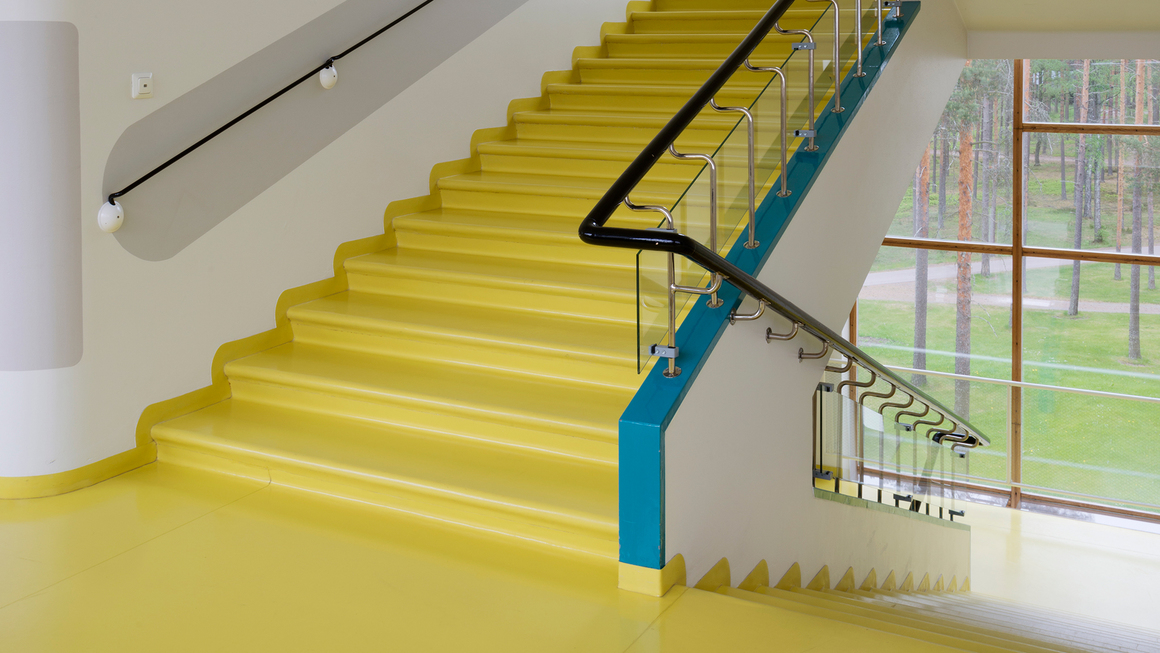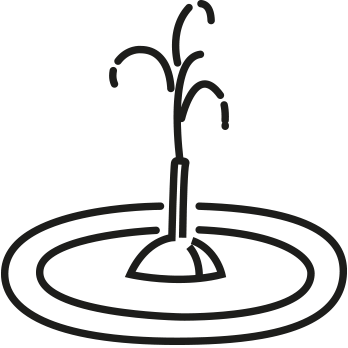
“Human life is a combination of tragedy and comedy. The shapes and designs that surround us are the music accompanying this tragedy and this comedy,” said Alvar Aalto, whose approach to design and production was defined by both his exacting attention to detail and, conversely, a lightness of touch. Considered one of the less dogmatic faces of modernism (at the Riihitie House in Helsinki—which he and his wife Aino designed, lived, and worked in—among the Japanese-influenced decor and modernist furniture was Alvar’s favorite armchair, a sturdy blue seat as aesthetically out of place as it was comfortable), Aalto’s designs embraced both International Style and the practicalities of people’s wants and needs.
In his designs for the Paimio Sanatorium—a tuberculosis sanatorium near Turku, Finland, built in 1929 after Aalto was awarded the commission in an architectural competition—Aalto’s intention was to build “a cathedral to health and an instrument for healing”; an environment that, before medical treatments for tuberculosis had become available, could provide the literal breathing space that was thought to help rehabilitate patients. Set on a sandy terrain in the middle of a pine forest, the main building sits at the area’s highest point—a central core from which various wings jut out into the forest. The patients’ quarters and sun deck face south, filling the rooms with natural light—the heat broken up in the shade of the pines—and allowing patients to follow the course of each day. The walls are white and the ceilings a muted shade of green, which Aalto thought would make the general tone more peaceful from the perspective of a recumbent patient; the lighting is set both above and below sight line to avoid glare, and almost every detail of the furniture in patient rooms is curved. The door handle leading into the room loops inwards to avoid catching on sleeves, wardrobe doors form soft waves, and the sinks were designed to sit on an angle that would reduce splashing noises, to avoid waking roommates.
Curved forms were integral to the design of the Paimio Sanatorium—and throughout Aalto’s practice—from the edges of the building itself to the reception desk, walkways, staircases, and furniture. The Paimio chair, designed to be its namesake’s staple seat, was made from cantilevered birch wood bent into scrolls—taking form in two closed loops of laminated wood that support the central seat, angled back for optimum ease of breath. It’s Aalto’s best-known piece of furniture, which at the time tested the limits of plywood manufacturing, inspired his peers—including Charles and Ray Eames, and Eero Saarinen—and was one of the works that drove the Congrès Internationaux d’Architecture Moderne to, in 1933, cite him as “the new voice from the northern fringe of Europe that was soon to add color and richness to their somewhat austere vocabulary.” And while Aalto did receive acclaim from his peers and the design establishment, it was the general public, in Finland in particular, who’d been the first to embrace him. Pieces produced by his and Aino Aalto’s company, Artek, furnished not only Aalto buildings but schools and public buildings across Finland as well.
The color and richness of Aalto’s practice went far beyond the literal sense of these terms; how it really came through was in the form of broad influences, experiences, and viewpoints. With an approach more complex than being straightforwardly modernist, for Paimio, Aalto placed International Style within the context of ancient cultures, Finnish traditions, and new knowledge, as well as, fundamentally, the needs of the people inhabiting the space. It was this pragmatism, somehow both inspired and practical, this openness, and this lack of pomposity that allowed him to appeal to both the people and the establishment—and be known for both “pushing the vocabulary” of modernism and grounding his work in the requirements of everyday life.
While today most of the original interior details at the Paimio Sanatorium have been replaced or repainted, the colors and forms still adhere to Aalto’s vision. The stairs are banana-yellow with a turquoise trim; the cafeteria walls are dappled with pink light from the bright marquees and the room completed with similarly “candy” orange chairs; and mint-green details line the communal areas and patient rooms. On the one hand, the color choices may be seen to undermine the principles of Functionalism and the practicalities that defined so many of Aalto’s design choices; but on the other, the proposition that design ought to be either purely functional or purely decorative misses the mark. It misses the difficult fact of people, and the contradictions and complexities that make up our wants and needs—it misses the value, and functionality, of having music to accompany the tragedy and comedy of life.
In his designs for the Paimio Sanatorium—a tuberculosis sanatorium near Turku, Finland, built in 1929 after Aalto was awarded the commission in an architectural competition—Aalto’s intention was to build “a cathedral to health and an instrument for healing”; an environment that, before medical treatments for tuberculosis had become available, could provide the literal breathing space that was thought to help rehabilitate patients. Set on a sandy terrain in the middle of a pine forest, the main building sits at the area’s highest point—a central core from which various wings jut out into the forest. The patients’ quarters and sun deck face south, filling the rooms with natural light—the heat broken up in the shade of the pines—and allowing patients to follow the course of each day. The walls are white and the ceilings a muted shade of green, which Aalto thought would make the general tone more peaceful from the perspective of a recumbent patient; the lighting is set both above and below sight line to avoid glare, and almost every detail of the furniture in patient rooms is curved. The door handle leading into the room loops inwards to avoid catching on sleeves, wardrobe doors form soft waves, and the sinks were designed to sit on an angle that would reduce splashing noises, to avoid waking roommates.
Curved forms were integral to the design of the Paimio Sanatorium—and throughout Aalto’s practice—from the edges of the building itself to the reception desk, walkways, staircases, and furniture. The Paimio chair, designed to be its namesake’s staple seat, was made from cantilevered birch wood bent into scrolls—taking form in two closed loops of laminated wood that support the central seat, angled back for optimum ease of breath. It’s Aalto’s best-known piece of furniture, which at the time tested the limits of plywood manufacturing, inspired his peers—including Charles and Ray Eames, and Eero Saarinen—and was one of the works that drove the Congrès Internationaux d’Architecture Moderne to, in 1933, cite him as “the new voice from the northern fringe of Europe that was soon to add color and richness to their somewhat austere vocabulary.” And while Aalto did receive acclaim from his peers and the design establishment, it was the general public, in Finland in particular, who’d been the first to embrace him. Pieces produced by his and Aino Aalto’s company, Artek, furnished not only Aalto buildings but schools and public buildings across Finland as well.
The color and richness of Aalto’s practice went far beyond the literal sense of these terms; how it really came through was in the form of broad influences, experiences, and viewpoints. With an approach more complex than being straightforwardly modernist, for Paimio, Aalto placed International Style within the context of ancient cultures, Finnish traditions, and new knowledge, as well as, fundamentally, the needs of the people inhabiting the space. It was this pragmatism, somehow both inspired and practical, this openness, and this lack of pomposity that allowed him to appeal to both the people and the establishment—and be known for both “pushing the vocabulary” of modernism and grounding his work in the requirements of everyday life.
While today most of the original interior details at the Paimio Sanatorium have been replaced or repainted, the colors and forms still adhere to Aalto’s vision. The stairs are banana-yellow with a turquoise trim; the cafeteria walls are dappled with pink light from the bright marquees and the room completed with similarly “candy” orange chairs; and mint-green details line the communal areas and patient rooms. On the one hand, the color choices may be seen to undermine the principles of Functionalism and the practicalities that defined so many of Aalto’s design choices; but on the other, the proposition that design ought to be either purely functional or purely decorative misses the mark. It misses the difficult fact of people, and the contradictions and complexities that make up our wants and needs—it misses the value, and functionality, of having music to accompany the tragedy and comedy of life.
Originally published by Maharam Stories.

